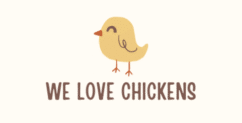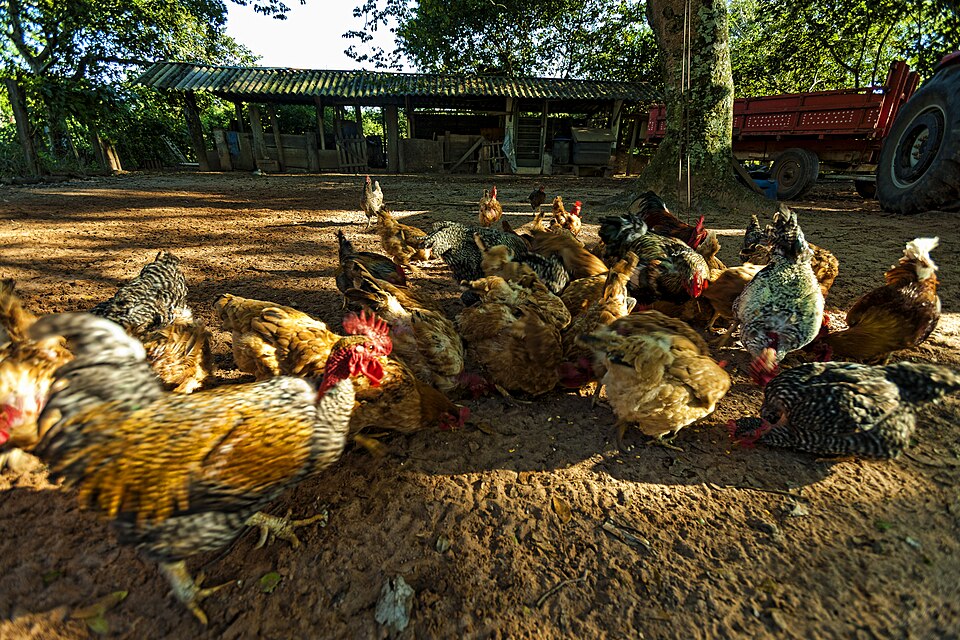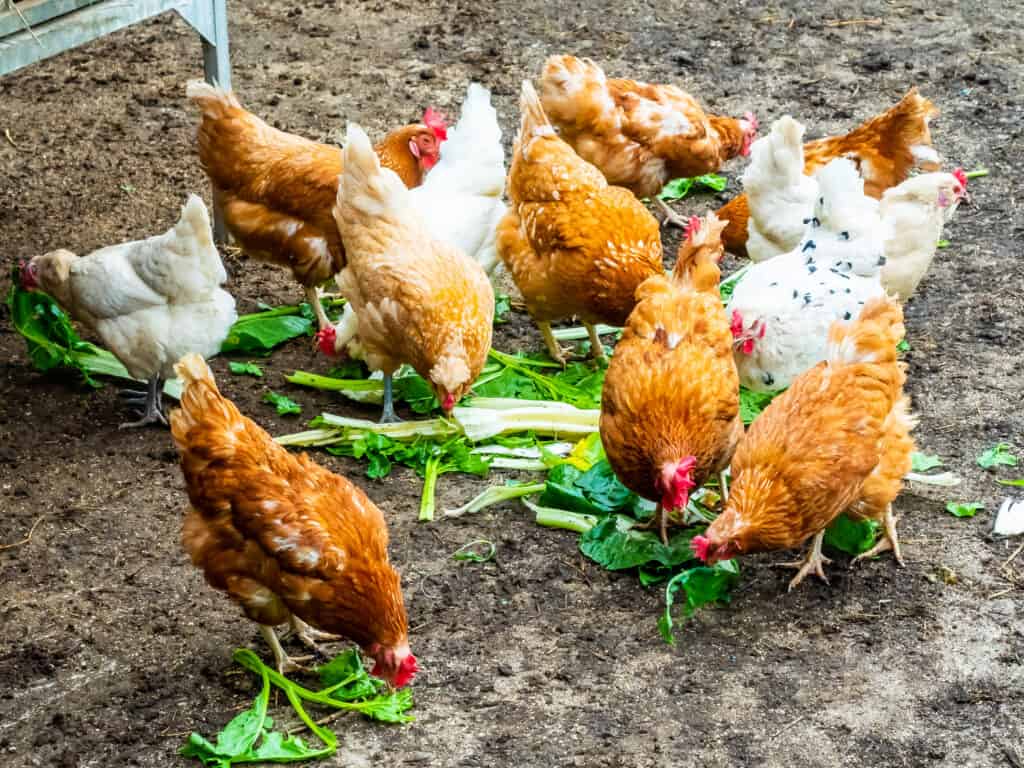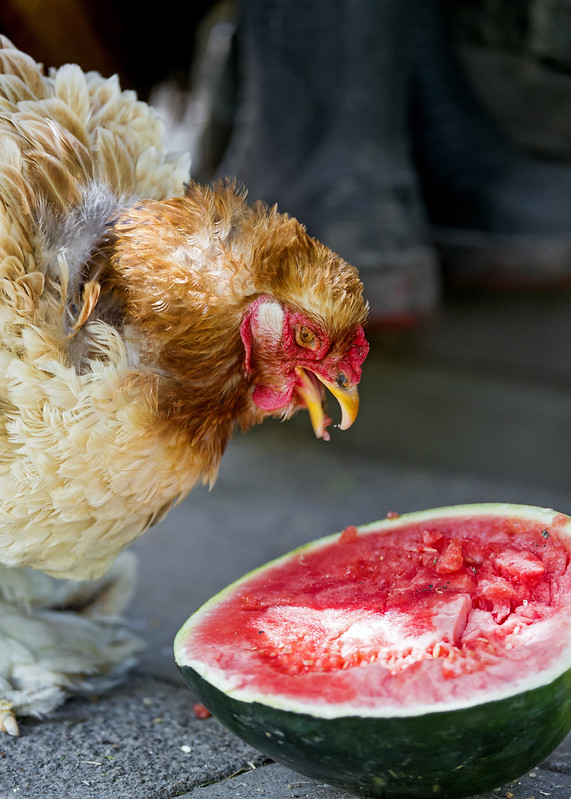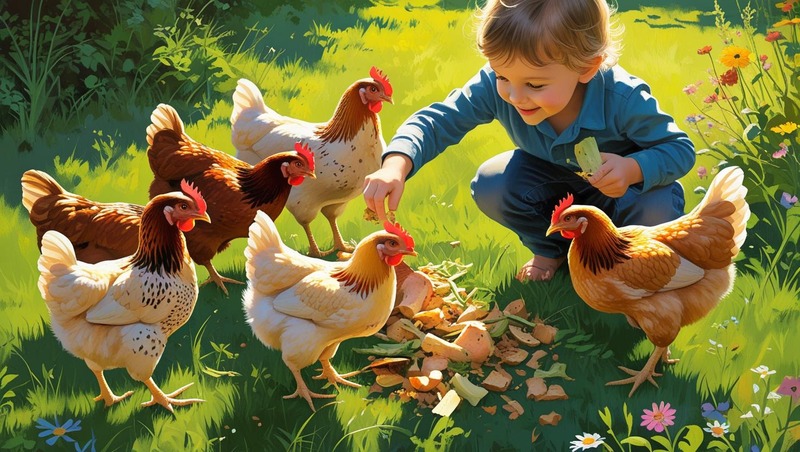I remember standing in the feed store on my first day — totally confident until I saw 12 different types of feed and absolutely zero idea what my hens actually needed. Crumble or pellet? Layer or starter? Do they eat grass? Bugs? Leftovers?
Turns out, feeding chickens is simpler than it looks — once you understand the basics. The goal is to give them a diet that keeps them healthy, productive, and happy without overcomplicating your life. This guide breaks it down for every stage of their life, what treats are okay, what to avoid, and how to avoid common feeding mistakes most new chicken keepers make.
Let’s start with the foundation:
What Chickens Eat (In Plain Terms)
Chickens can eat a lot of things, but that doesn’t mean everything they peck at is good for them. What they need is a basic diet that covers energy, protein, and calcium — plus a few extras depending on how they’re raised.
Grains and Energy. Most people feed a commercial mix, but it all comes down to grain. Corn, wheat, barley — that’s what gives chickens the fuel they need to stay warm, scratch around, and lay consistently. You can also offer whole grains or cracked corn as a supplement, especially in winter.
Protein. This matters more than most new keepers realize. Chickens use protein for egg production and regrowing feathers, especially during molting season. Good layer feed has it built in, but you can also give them a boost with mealworms, sunflower seeds, or even a bit of hard-boiled egg now and then.
Calcium. If your hens are laying, they burn through calcium fast. It keeps their eggshells strong and helps avoid issues like soft eggs or shell-less eggs. Offer crushed oyster shell in a separate dish — they’ll take what they need.
Scraps and Greens. Most backyard chickens get a mix of leftovers, veggie scraps, and garden weeds. That’s fine, as long as it’s not moldy or salty. A handful of chopped greens or melon rinds keeps them busy and adds variety.
Grit. If your flock doesn’t free-range, they’ll need grit — small rocks they swallow to help grind up food. It’s cheap, easy to add to a dish or sprinkle on the ground, and it prevents a lot of digestive issues down the line.
What to Feed Chickens at Every Life Stage
Feeding your chickens the right way depends on how old they are. A chick’s needs are totally different from a laying hen’s — and feeding the wrong thing at the wrong time can cause real issues. Here’s how I break it down from experience:
Chicks (0 to 8 Weeks Old)
Chicks grow like crazy. In just a few weeks, they go from fluff balls to feathered little birds — and they need a lot of support during that time.
- I always start mine on chick crumble. It’s soft enough for them to eat without trouble and has everything packed in — about 20–22% protein.
- I don’t give them any scraps or treats at first. Their digestive systems are just getting started.
- If I do offer something like a pinch of hard-boiled egg after a week or so, I make sure to sprinkle some chick grit in their brooder. Without grit, they can’t digest anything outside of feed properly.
Pullets (8 to 18 Weeks Old)
Once chicks start looking like skinny teenagers, it’s time to switch gears.
- I move them to a grower feed with slightly less protein (around 16–18%) and no added calcium.
- Still no layer feed — they’re not ready for that. Too much calcium at this stage can mess with their kidneys.
- At this point, I’ll toss in a few garden treats here and there, just to get them used to variety — but never too much at once.
Laying Hens (18+ Weeks)
Once you start seeing your first egg, everything changes — including their diet.
- I switch my hens to a layer feed around this time. It has the right balance of protein (usually 16%) and extra calcium they need for strong shells.
- But I don’t rely on feed alone for calcium. I always put a separate dish of crushed oyster shell in the coop. Hens will help themselves when they need it — and the ones who don’t need it will leave it alone.
- As for treats, I do give them fruit or greens every few days, especially in the summer when things grow fast in the garden. But I try to keep treats under control — too many scraps can mess up their diet and reduce egg production.
Roosters or Non-Laying Hens
Often overlooked when it comes to feeding, roosters don’t require the same nutrients as layers do.
- I don’t give roosters layer feed. Too much calcium can build up and cause problems long-term.
- If I have a mixed flock (hens + roosters), I’ll often use a flock raiser feed that’s suitable for everyone and just keep oyster shell on the side for the laying hens.
- Roosters still love treats and garden scraps, but they need nutritious protein just like the girls. Mine go nuts for black soldier fly larvae and even leftover scrambled eggs.
Some breeds are easier to manage, especially for new keepers — here’s a list of beginner-friendly chicken breeds worth considering.
Guidelines for Feeding Chickens: Amount and Frequency
People always ask how much feed chickens need — and honestly, it depends on a few things. The breed, how much they free-range, and even the season can change how much they eat. But here’s what works for most backyard flocks:
Free-Choice Feeding
I keep it simple: I give my chickens full access to feed all day. This approach is called free-choice feeding — just keep their feeder filled, and they’ll eat what they need. Chickens don’t usually overeat their main feed if it’s balanced and not loaded with junk.
I refill feeders once a day in the morning and make sure they stay clean and dry. You should avoid feeding them wet or moldy feed.
How Much Do They Eat Per Day?
On average, each adult hen eats about ¼ pound of feed per day. That’s roughly
- 1 cup of pellets or crumbles, give or take
- A 50 lb bag of feed will last 4–5 hens about 5–6 weeks.
If your birds are free-ranging, they may eat a little less — especially in the spring and summer when bugs and weeds are everywhere.
Water Matters Just as Much
Clean, fresh water is more important than most new keepers realize. If chickens don’t have access to water, they’ll stop eating. In hot weather, I check their water twice a day and rinse the container out — not just refill it.
| Flock Type | Feed Type | Amount (Daily) | Notes |
|---|---|---|---|
| Chicks (0–8 weeks) | Starter feed (20–22% protein) | ~1/4 cup per chick | No treats first 2 weeks. Add chick grit if giving extras. |
| Pullets (8–18 weeks) | Grower feed (16–18% protein) | ~1/3 cup per bird | Avoid layer feed. Treats okay in moderation. |
| Laying Hens | Layer feed (16% protein + calcium) | ~1/4 lb per bird (≈1 cup) | Provide oyster shell in separate dish. |
| Roosters / Non-Layers | Flock raiser or grower feed | ~1/4 lb per bird | Avoid calcium-heavy feed. Use grit as needed. |
Do Chickens Need Grit and Oyster Shell?
This one confuses a lot of new chicken keepers — and I get why. You walk into the feed store, and suddenly there’s a whole shelf of little bags labeled grit and oyster shell. Do you need both? Are they the same thing?
Not at all.
What Is Grit?
Chickens don’t have teeth. So to break down anything other than crumble or pellets — think grass, seeds, bugs, kitchen scraps — they need grit in their gizzard. Grit is basically tiny stones they swallow to help them grind up food.
- Chicks (0–8 weeks): Use chick grit if you’re feeding anything besides starter feed.
- Older chickens: Need regular grit if they’re eating anything beyond commercial feed.
- Free-range birds: Might find enough grit outside — but I still keep a dish out just in case.
You don’t need to mix it into their feed. Just offer it in a small separate bowl or sprinkle some on the ground. They’ll take what they need.
What Is Oystershell?
This is for calcium, not digestion.
Laying hens use a ton of calcium to form eggshells — and if they don’t get enough, their bodies will pull it from their bones. Not good.
- Oyster shell is the most common calcium supplement. It’s cheap, simple to offer, and hens will take it when they need it.
- Important: Never mix oyster shell into the feed. Let the hens self-regulate.
- If you’re raising non-layers (pullets, roosters, or older hens), they shouldn’t eat layer feed or added calcium regularly. That’s why a separate oyster shell dish works best — only layers will touch it.
Proper spacing in your coop and run can help reduce food waste and prevent pecking order issues — here’s a detailed guide on how much space your chickens really need.
Can Chickens Eat Table Scraps?
Yes, chickens can eat table scraps — and they love them. But just like people, they do better with balance.
Scraps are a delightful, low-cost way to supplement their diet and reduce waste at home. Still, they shouldn’t make up more than about 10% of what your chickens eat. Treat scraps like dessert — not dinner.
Scraps That Work Well
From my kitchen to the coop, here are scraps I give regularly (in small portions):
- Vegetable peels and trimmings — carrots, lettuce, zucchini, and squash
- Fruit scraps — apple cores (no seeds), melon rinds, berries, grapes
- Cooked grains or pasta — plain rice, oats, and whole-grain bread
- I feed my chickens cooked eggs, which I prepare by scrambling or boiling them first. Just scramble or boil them first.
I always double-check there’s no mold, grease, or added salt before tossing anything in the run.
What to skip?
Some foods are a flat no—they can make chickens sick or even kill them.
- Avocado (especially pit and skin)—contains persin, which is toxic
- Chocolate and caffeine—toxic to birds.
- Raw potato peels and green potatoes contain solanine, which poses a risk.
- Raw or dried beans—harmful unless thoroughly cooked.
- Anything moldy, spoiled, or overly salty
Furthermore, avoid meat and dairy in large amounts — a tiny bit is usually fine, but too much can cause digestive upset and attract pests.
| Safe Table Scraps | Unsafe Table Scraps |
|---|---|
| Cooked rice or oats | Avocado (especially pit and skin) |
| Leafy greens (lettuce, kale, spinach) | Chocolate and caffeine |
| Cooked eggs (scrambled or boiled) | Raw potato peels / green potatoes |
| Fruit (apples without seeds, berries, melon) | Raw or dried beans (unless fully cooked) |
| Vegetable peels (carrots, squash, zucchini) | Moldy or spoiled food |
| Plain pasta or whole grain bread | Salty, greasy, or highly processed foods |
| Pumpkin and squash seeds | Large amounts of meat or dairy |
Final Thoughts: Feeding Chickens the Right Way
Feeding chickens isn’t complicated once you understand the basics — but it’s easy to make mistakes if you go in blind. What they eat affects everything from egg quality to flock health and even behavior.
If you follow these simple guidelines:
- Match the feed to their age and purpose.
- Keep clean water and feed available at all times.
- Use grit and oyster shell properly, based on their needs.
- Offer healthy scraps in moderation.
…you’ll be off to a great start.
I’ve learned a lot by trial and error over the years, but feeding has never been something to overthink. Start with good feed, observe your birds, and adjust as you go. Chickens are surprisingly good at telling you what’s working—and what’s not.
Resources:
